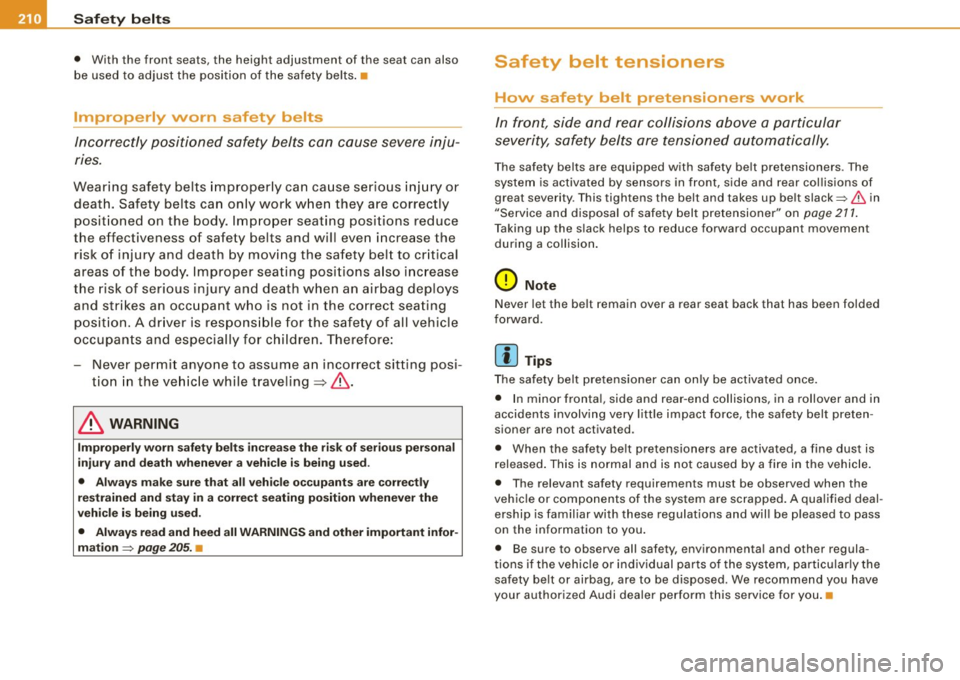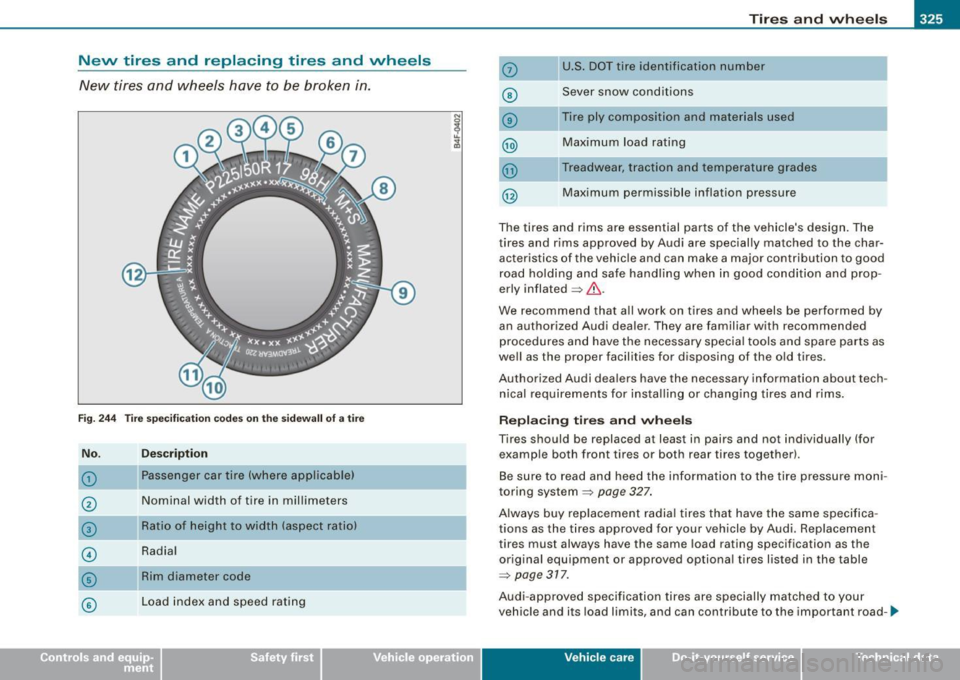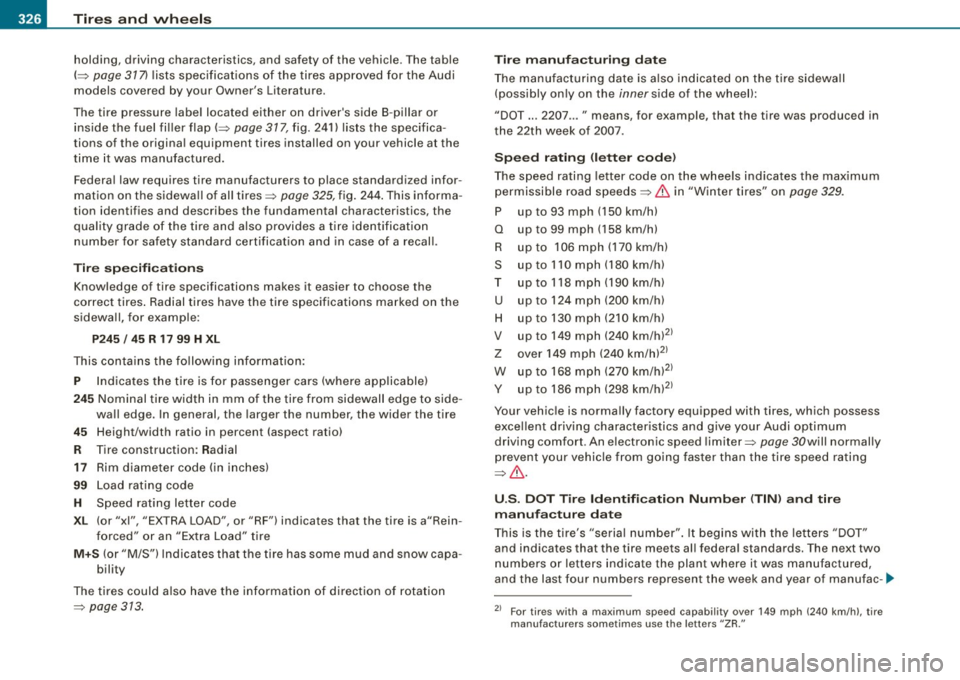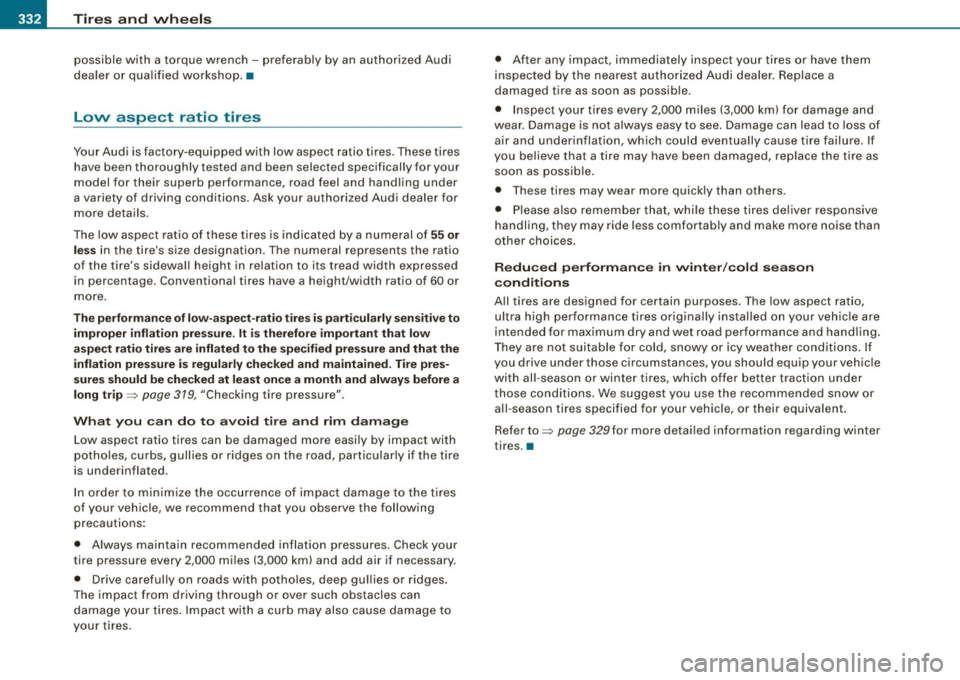2008 AUDI S6 height
[x] Cancel search: heightPage 211 of 390

& WARNING
Improperly positioned safety belts can cause serious personal
injury in an accident.
• Expectant mothers must always wear the lap portion of the
safety belt as low as possible across the pelvis and below the
rounding of the abdomen.
• Always read and heed all WARNINGS and other important infor
mation
=> & in "Fastening safety belts" on page 206. •
Unfastening safety belts
Unbuckle the safety belt with the red release button only
after the vehicle has stopped.
~ .. a,
Fig . 201 Releasing the
tongue from the buckle
- Push the red release button on the buckle~ fig. 201. The
belt tongue will spring out of the buckle
~ & .
- Let the belt wind up on the retractor as you guide the belt
tongue to its stowed position.
& WARNING
Never unfasten safety belt while the vehicle is moving. Doing so
will increase your risk of being injured or killed. •
Safety first
Safety belts
Adjusting safety belt height
With the aid of the safety belt height adjustment, the three
point safety belt strap routing can be fitted to the shoulder
area, according to body size.
Fig . 202 Safety belt
height adjustment for
the front seats -loop
around fittings
Push the loop -around fittings up ~ fig. 202 @, or
- squeeze together the G) button, and push the loop
around fittings
down @.
- Pull the belt to make sure that the upper attachment is
properly engaged.
& WARNING
Always read and heed all WARNINGS and other important informa
tion
=> page 205.
[ i ] Tips
• The shoulder belt part should route approximately over the
middle of your shoulder -under no circumstances should it route
over your neck and throat area=>
& in "Safety belt position" on
page~Z •
•
Vehicle care I I Technical data
Page 212 of 390

• ....__S_ a_ fe_ t _y=-- b_ e_ lt_s ________________________________________________ _
• With the front sea ts, the height adjustment of the seat can also
be used to adjust the position of the safety belts. •
Improperly worn safety belts
Incorrectly positioned safety belts can cause severe inju
nes.
Wearing safety belts improperly can cause serious injury or
death. Safety belts can only work when they are correctly positioned on the body. Improper seating positions reduce
the effectiveness of safety belts and w ill even increase the
risk of injury and death by moving the safety belt to critical
areas of the body. Improper seating positions also increase
the risk of serious injury and death when an airbag deploys
and strikes an occupant who is not in the correct seating
position. A driver is responsible for the safety of all vehicle
occupants and especially for children. Therefore:
-Never permit anyone to assume an incorrect sitting pos i
tion in the vehicle while traveling ~& .
& WARNING
Improperly worn safety belts increase the risk of serious personal
injury and death whenever a vehicle is being used.
• Always make sure that all vehicle occupants are correctly
restrained and stay in a correct seating position whenever the
vehicle is being used.
• Always read and heed all WARNINGS and other important infor
mation
~ page 205. •
Safety belt tensioners
How safety belt pretensioners work
In front, side and rear collisions above a particular
severity, safety belts are tensioned automatically.
The safety belts are equipped with safety belt pretensioners . The
system is activated by sensors in front, side and rear collisions of
great severity . This tightens the belt and takes up belt slack~
& in
"Service and disposal of safety belt pretensioner" on
page 211.
Taking up the slack helps to reduce forward occupant movemen t
during a collision.
0 Note
Never let the belt remain over a rear seat back that has been folded
forward .
[ i] Tips
The safety belt pretensioner can only be activated once.
• In minor frontal, side and rear -end collisions, in a rollover and in
accidents involving very little impact force, the safety belt preten
sioner are not activated .
• When the safety belt pretensioners are activated, a fine dust is
released. This is normal and is not caused by a fire in the vehicle.
• The relevant safety requirements must be observed when the
vehicle or components of the system are scrapped. A qualified deal
ership is familiar with these regulations and will be pleased to pass
on the information to you.
• Be sure to observe all safety, environmental and other regula
tions if the vehicle or individual parts of the system, particularly the
safety belt or airbag , are to be disposed . We recommend you have
your authorized Audi dealer perform this service for you. •
Page 316 of 390

-~_T_ ir_e_ s_ a_ n_d _ w_ h_ e_e _l_s _________________________________________________ _
& WARNING (continued)
crashes and serious personal injuries . Have worn or damaged tires
replaced immediately.
• Tires age even if they are not being used and can fail suddenly,
especially at high speeds. Tires that are more than 6 years old can
only be used in an emergency and then with special care and at
low speed.
Glossary of tire and loading terminology
Accessory weight
means the combined weight (in excess of those standard items
which may be replaced) of automatic transmission, power steering,
power brakes, power windows, power seats, radio, and heater, to
the extent that these items are available as factory-installed equip
ment (whether installed or not).
Aspect ratio means the ratio of the height to the width of the tire in percent.
Numb ers of 55 or lower indicate a low sidewall for improved
steering response and better overall handling on dry pavement.
Bead
means the part of the tire that is made of steel wires, wrapped or reinforced by ply cords and that is shaped to fit the rim.
Bead separation means a breakdown of the bond between components in the bead.
Cord
means the strands forming the plies in the tire.
& WARNING (continued)
• Never mount used tires on your vehicle if you are not sure of
their "previous history." Old used tires may have been damaged
even though the damage cannot be seen that can lead to sudden
tire failure and loss of vehicle control.
• If you notice unusual vibration or if the vehicle pulls to one side
when driving, always stop as soon as it is safe to do so and check
the wheels and tires for damage . •
Cold tire inflation pressure
means the tire pressure recommended by the vehicle manufacturer
for a tire of a designated size that has not been driven for more than
a couple of miles (kilometers) at low speeds in the three hour period
before the tire pressure is measured or adjusted .
Curb weight means the weight of a motor vehicle with standard equipment
including the maximum capacity of fuel, oil, and coolant, air condi
tioning and additional weight of optional equipment.
Extra load tire
means a tire designed to operate at higher loads and at higher infla
tion pressures than the corresponding standard tire . Extra load tires
my be identified as "XL",
"xi", "EXTRA LOAD", or "RF" on the side
wall.
Gross Axle Weight Rating ("GAWR")
means the load-carrying capacity of a single axle system, measured
at the tire -ground interfaces .
Gross Vehicle Weight Rating ("GVWR"l
means the maximum total loaded weight of the vehicle.
Page 327 of 390

Tires and wheels -_______________ _____.
New tires and replacing tires and wheels
New tires and wheels have to be broken in.
Fig. 244 Tire specification codes on the sidewall of a tire
No.
G)
@
©
©
©
©
Description
Passenger car tire (where appl icable)
Nominal width of tire in millimeters
Ratio of height to width (aspect ratio)
Radial
Rim diameter code
Load index and speed rating
0
©
U.S. DOT tire identificat ion number
Sever snow conditions
Tire ply composition and materials used
Maximum load rating
@ Treadwear, traction and temperature grades
@ Maximum permissible inflation pressure
The tires and rims are essential parts of the vehicle's design. The
tires and rims approved by Audi are specially matched to the char acteristics of the vehicle and can make a major contribution to good
road holding and safe handling when in good condition and prop
erly inflated =>& .
We recommend that all work on tires and wheels be performed by
an authorized Audi dealer. They are familiar with recommended
procedures and have the necessary special tools and spare parts as
well as the proper facilities for disposing of the old tires.
Authorized Audi dealers have the necessary information about tech
nical requirements for installing or changing tires and rims.
Replacing tires and wheels
Tires should be replaced at least in pairs and not individually (for
example both front tires or both rear tires together).
Be sure to read and heed the information to the tire pressure moni
toring system =>
page 327.
Always buy replacement radial tires that have the same specifica
tions as the tires approved for your vehicle by Audi. Replacement
tires must always have the same load rating specification as the original equipment or approved optional tires listed in the table
=> page 317.
Audi -approved specification tires are specially matched to your
vehicle and its load limits, and can contribute to the important road-.,_
Vehic le care I I irechnical data
Page 328 of 390

-~_T_ ir_e_ s_ a_ n_d _ w_ h_ e_e _l_s _________________________________________________ _
holding, driving characteristics, and safety of the vehicle. The table
(~ page 37 7) lists specifications of the tires approved for the Audi
models covered by your Owner's Literature .
The tire pressure label located either on driver 's side 8 -pillar or
inside the fuel fi ller flap (~
page 317, fig. 241) lists the specifica
tions of the original equipment tires installed on your vehicle at the
time it was manufactured.
Federal law requires tire manufacturers to place standardi zed infor
mation on the sidewa ll of al l tires ~
page 325, fig. 244 . T his informa
tion identifies and describes the fundamenta l characteristics, the
quality grade of the tire and also provides a tire identification
number for safety standard certification and in case of a recall.
T ire spe cifi catio ns
Knowledge of tire specifications makes it easier to choose the
correct tires . Radial tires have the tire specifications ma rked on the
sidewall, for example :
P245 / 45 R 17 99 H XL
This contains the fo llowing information :
P Ind icates the tire is for passenger cars (where app licable)
24 5 Nominal tire width in mm of the tire from sidewall edge to side -
wall edge. In general , the larger the number , the wider the tire
45 Height/width ratio in percent (aspect ratio)
R Tire construction: Radial
17 Rim diameter code ( in inches)
99 L oad rating code
H Speed rat ing letter code
XL (or "xi ", "EXTRA LOAD", or "RF") indica tes that the tire is a"Rein
forced" or an "Extra Load" tire
M +S (or "M/S") Indicates that the tire has some mud and snow capa
bili ty
The tires could also have the information of direction of rota tion
~ page 313.
Ti re manuf acturing d ate
T he manufacturing date is a lso indicated on the t ire sidewa ll
(possibly on ly on the
inner side of the wheel!:
"DO T ... 2207 ... " means, for example, that the tire was produc ed in
the 22th week of 2007.
S peed rating (lett er cod e)
The speed rating letter code on the whee ls indicates the maximum
permissible road speeds~
& in "Winter tires" on page 329.
P up to 93 mph ( 150 km/h)
Q up to 99 mph (158 km/h)
R upto 106mph(170km/h)
S up to110mph(180km/h)
T upto118mph(190km/h)
U up to 124 mph (200 km/h)
H up to 130 mph (210 km/h)
V up to 149 mph (240 km/h)21
Z over 149 mph (240 km/h)21
W up to 168 mph (270 km/h)21
Y up to 186 mph (298 km/h)21
Your vehic le is normally factory equipped with tires, which possess
excellent driving characteristics and give your Audi op timum
driving comfort . An e lectron ic speed limiter~
page 30will normal ly
prevent your vehic le from going faster than the tire speed rati ng
~ & -
U.S. DOT Tire Ident ification Numb er (TIN ) and tire
m anuf acture d ate
This is the tire's "seria l number" . It begins with the letters "DOT"
and indicates that the tire meets al l federa l standards. The next two
numbers or letters ind icate the plant where it was manufactured,
and the last four numbers represent the week and year of manufac -
~
21 For tires w ith a maximum speed capab ility over 149 mph (240 km /h ), tire
manufacture rs som etim es us e th e lette rs "ZR."
Page 334 of 390

-Tires and wheels
PW-------------------
possible with a torque wrench -preferably by an authorized Audi
dealer or qualified workshop. •
Low aspect ratio tires
Your Audi is factory-equipped with low aspect ratio tires . These tires
have been thoroughly tested and been selected specifically for your
model for their superb performance, road feel and hand ling under
a variety of driving conditions . Ask your authorized Audi dealer for
more details.
The low aspect ratio of these tires is indicated by a numeral of
55 or
less
in the tire's size designation. The numeral represents the ratio
of the tire's sidewa ll height in relat ion to its tread width expressed
in percentage. Conventional tires have a height/width ratio of 60 or
more.
The performan ce of low -aspect-ratio tires is particularly sensitive to
improper inflation pressure. It is therefore important that low
aspect ratio tires are inflated to the specified pressure and that the
inflation pressure is regularly checked and maintained. T ire pres
s ures should be checked at least once a month and always before a
long trip => page 379,
"Checking tire pressure".
What you can do to avoid tire and rim damage
Low aspect ratio tires can be damaged more easily by impact with
potho les, curbs, gullies or ridges on the road, particularly if the tire
is underinflated.
In order to minimize the occurrence of impact damage to the tires
of your vehicle, we recommend that you observe the following precautions:
• Always ma inta in recommended inflation pressures. Check your
tire pressure every 2,000 miles (3,000 km) and add air if necessary.
• Drive carefully on roads with potholes, deep gu llies or ridges.
The impact from driving through or over such obstacles can
damage your tires. Impact with a curb may also cause damage to
your tires . •
After any impact, immediately inspect your tires or have them
inspected by the nearest authorized Audi dealer. Replace a
damaged tire as soon as possible.
• Inspect your tires every 2,000 miles (3,000 km) for damage and
wear. Damage is not always easy to see. Damage can lead to loss of
air and underinflation, which could eventually cause tire failure. If
you believe that a tire may have been damaged, replace the tire as
soon as possib le.
• T hese tires may wear more quickly than others .
• Please also remember that, whi le these tires deliver respons ive
handling, they may ride less comfortably and make more noise than
other choices .
Reduced performance in winter /cold season
conditions
A ll tires are designed for certain purposes. The low aspect ratio,
u ltr a high performance tires originally installed on your vehic le are
intended for maximum dry and wet road performance and handling.
They are not suitable for cold, snowy or icy weather conditions. If
you drive under those circumstances, you should equip your vehic le
with all -season or winter tires , wh ich offer better traction under
those conditions. We suggest you use the recommended snow or all -season tires specified for your vehicle, or their equivalent .
Refer to=>
page 329for more detailed information regarding winter
tires. •
Page 365 of 390

_____________________________________________________ D_a_ t_ a __ llll
Data
Ap plies to veh icles: wit h 3.2 lit er 6 -c ylinde r en gine
255 hp, 6-cylinder engine
En gin e da ta
Maximum output SAE net
Maximum torque SAE net
No . of cylinders
Displacement
Stroke
Bore
Compression ratio
Fuel
Dim ension s (app rox.)
Length (with licence plate bracket)
Width (with outside mirrors fo lded)
Height (unloaded)
Turning circle diameter (curb to curb)
Ca pac ities (a pprox.)
F u el t ank
-Total capacity
- Reserve (of total capacity)
Wind shi eld and he adli ght * was her fluid container
E ngine oil
with filter change
Controls and equip
ment Safety first
hp@rpm
lb-ft@ rpm
CID (cm
3
)
in (mm)
in (mm)
255@ 6500
243@3250
6 cylinder
191 (3123)
3.65 (92.8)
3.33 (84.5) 12.5 : 1
Premium unleaded (91 AKI) Recommended for maximum engine performance. Fur
ther details =>
page 297, "Gasoline"
in (mm)
in (mm)
in (mm)
ft (ml
193 .5 (49 16)
73.0 (1855) 57 .4 (1459)
39 .0 (11.9)
gal Oiters)
gal (liters)
quarts (liters)
quarts (liters ) 21.1 (80.0)
1 .8-2 .4 (7 -9)
5 .1 (4 .8)
6 .9 (6 .5)
•
Vehicle operation Vehicle care Do-it-yourself service Tec hn ica l da ta
Page 366 of 390

___ D_a_ t_ a ___________________________________________________ _
Applies to vehi cles : with 4 .2 l iter a-c ylinder e ngine
350 hp , a-cylinder engine
Engine data
Max imum output SAE net
Maximum torque SAE net
N o. of cy linders
Disp lacement
Stroke
Bo re
Comp ress ion ratio
Fuel
Dimensions (appro x.)
Length (with licence plate brac ket)
Width (wit h outside mirrors folded)
Height (un loaded)
Turning c ircle diameter (curb to curb)
Capacities {approx .)
Fuel tank
-Total capacity
- Reserve (of total capacity)
Windshield and headlight* washer fluid container
Engine oil
with filter change hp@ rpm
lb-ft@ rpm
CID (cm
3
)
in (mm)
in (m m) 350@6800
325@ 3500
8 cylinder
254 (4163)
3 .65 (92 .8)
3 .33 (84 .5)
12. 5: 1
Premium unleaded {91 AKll Recommended for maximum engine performance . Fur
ther details =:>
page 291, "Gasoline"
in (m m)
in (m m)
in (mm)
ft (ml 193
.5 ( 4916)
73.0 (1855)
57.4 ( 1459)
39 .0 (1 1.9)
gal (l iters)
gal (li ters)
quarts (liters)
quarts (l iters) 21.1 (80
.0)
1 .8 -2 .4 (7 -9)
5.1 ( 4.8)
9. 6 (9 .1)
•